This first list of medals is ranked from the highest award to lowest. This list is largely the award structure of the American Iris Society which is voted on exclusively by its registered judges. This ranking represents a progression, with Irises only being eligble for a higher award once they have first achieved the award below. The exception to the all American system is the highest award, the Dykes Medal which is essentially a British award which is granted separately in different world regions.
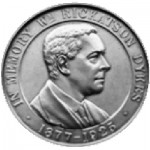
The Dykes Medal
This is the highest award for irises of any type and is awarded in the respective nations, continents or geographical area in which the cultivar was bred. Each Dykes Medal is awarded to only 1 Iris each year..
The Dykes Medal was originally awarded in the UK (~1926/7), but a Medal was later offered to France (and then subsequently withdrawn because the same hybridizer won each year ), and also to the USA & Australia. Australia incorporates New Zealand, but they have had problems working out how to award it. I believe that the current process is for NZ to get it one year, Australian Tall Bearded Irises the next and Australian beardless (LAs) the third. The US medal also covers Canada. The United Kingdom covers everywhere else. This is effectively. Europe, but the iris have to be trialled in the UK. Judging is done locally and advised to the British Iris Society (BIS) which has the medals struck and engraved before sending them overseas where they are presented to the winners.
The Medal is named and awarded to honour William Rickatson Dykes who wrote the monograph “The Genus Iris”. In 1926 he was the first person to hybridize a yellow Tall Bearded Iris, which was named for him, but he died very soon after its introduction in a motorcycle accident.
Classification Medals
Irises are eligible to be considered for their respective classification medal in the second year following recognition by an Award of Merit
The Morgan Award and The Morgan-Wood Medal
The Morgan Award, granted annually, was the highest award given exclusively to Siberian Irises within the American Iris Society. It was awarded from 1952 through to 1984 when it was superseded by the Morgan-Wood Medal. The Morgan-Wood Medal took over from the Morgan Wood Award, being the highest award in the American Iris Society reserved exclusively for Siberian Irises. It began in 1986 and is still awarded annually.
The name commemorates two people. Henry Morgan was a pioneering department store owner, founder of Henry Morgan & Company in Quebec, Canada. He was Scottish born and became a great patron of the Arts and a breeder of Siberian Irises. Iris ‘Tropic Night’ was one of his breeding. Ira E.Wood (Sandy) worked for Bell Laboratories in New Jersey along with his wife Betty. They were both active members of the AIS and the Society for Siberian Irises. The AIS awarded them both a distinguished service medal.
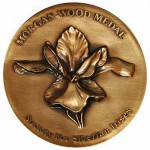
Founders of SIGNA Medal
This is one of the newest awards granted by the American Iris Society, having first been awarded in 2001. It was named in honour of the Founders of the Species Iris Group of North America (SIGNA) and can be awarded to any species iris variety.
The first issue of SIGNA’s publication, produced in 1968, lists 40 charter members. Dedicated to species Iris and first generation crosses SIGNA accumulates a wealth of information on Iris which it is dedicated to collating and preserving in a permanent and accessible form. SIGNA has flourished from its first instigation, ably guided by the leadership of its first Chairman, Roy Davidson.
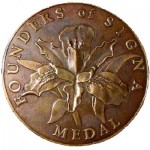
Randolph Perry Medal
Another relatively new award in the gift of the American Iris Society, having been first awarded in 2000. It is named in honour of Dr. L. F. Randolph (1894-1980) and Amos Perry (1871-1953). It can be awarded to any inter-species cross.
‘Fritz’ Ranolph was a professor of Botany at Cornell University where he was an acknowledged expert on both Corn and Orchids. He performed many expeditions where he collected Iris, added to Iris knowledge through studies conducted with his students and was Chairman of the AIS Scientific Committee from 1945-56. He was honoured by both the American and British Iris Societies.
Amos Perry was a British Nurseryman, responsible for breeding a wealth of good garden plants. His interests encompassed not only Iris but also Poppies, Delphiniums, Asters and Daylillies amongst others. He is perhaps best known through his two oriental poppies, Mrs Perry and Perry’s White. His Iris ‘Margot Holmes’ was the first to be awarded the British Dykes Medal.
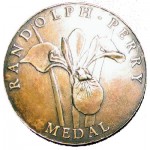
Award of Merit
This is granted to Irises that have proven of value over at least five years since their introduction. Irises are eligible for consideration in the second year following the granting of an Honourable Mention
Honourable Mention
This is the first true rung on the awards ladder. Awarded annually to Irises of all classifications. An Iris becomes eligible in the third year following its introduction. Before this point a seedling Iris that has not been introduced into commerce can be considered for the award of Highly Commended.
Popularity Medals
This second list contains awards that are voted on by the wider membership of the American Iris Society (not just the judges) and also the AGM, which is a British award given to any garden plant that has proved its worth in trials.

Franklin Cook Memorial Cup
The Franklin Cook Memorial Cup is awarded each year during The American Iris Society’s national meeting. It is open to all Irises that members have seen growing in tour gardens in that year. Each member votes for one Iris and the Cup goes to the Iris, of any classification, that receives the highest votes. Irises originating in the region hosting the conference are eligible for the President’s Cup.
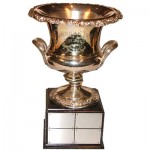
The Fred and Barbara Walther Cup
The Fred and Barbara Walther Cup is awarded annually by The American Iris Society. It is awarded to the Iris that has received the greatest number of votes in the Honorable Mention (HM) award balloting. It can be awarded to any Iris, regardless of its classification and is granted by Honourable Mention Judges only.
The Award of Garden Merit is awarded by the Royal Horticultural Society to plants that have proved themselves garden worthy following trials at the RHS Wisley and elsewhere in the country. It can be given to any garden plant, but in the case of Iris it is a status that was granted by the RHS Iris Committee. It can potentially be reviewed annually and withdrawn.
The Iris trials at Wisley started in 1926 and ran continuously, an existing trial being replanted after its 3-year run was over, until about 2010, when new ideas were brought in. The last trial finished in 2015 and to my knowledge, there are no current iris trials, although I believe a trial of “winter iris” i.e. reticulate bulbs is planned.
It is now the responsibility of The Herbaceous Committee to award iris AGMs. The fact that they have only 2 irisarians on the committee is, as Clive says, ‘A sorry state of affairs!’
AGM

















































